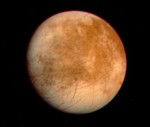GALILEO
Galileo Energetic Particles Detector
EPD Highlights During the Galileo Mission
Source: D. Williams, EPD Team Meeting, March 1998
|
|
|
|
- Discovery of intense, bidirectional, field-aligned energetic electron beams streaming along the Io fluxtube. If they fill the Io fluxtube, they carry sufficient energy to Jupiter's atmosphere to generate aurorae at the foot of the Io fluxtube.
- Use of energetic electron angular distributions observed at Ganymede to measure the surface magnetic field of Ganymede and verify its internal field.
- Discovery of energetic electrons trapped in Ganymede's magnetic field, identifying closed Ganymede magnetic field lines and further substantiating the concept of a Ganymede magnetosphere. Note that Ganymede's magnetosphere is larger than that of Mercury.
- First measurement of the amount of pitch angle scattering that occurs for energetic electrons during their travel from Ganymede to the near-Jupiter mirror point and back. The energy-dependent pitch angle diffusion coefficient was extracted from the data.
- First possible observation of fluxtube interchange in the Io torus, providing a measure of particle transport through this region and into the Jovian magnetosphere.
- Measurement of heavy ion intensities in Io's torus show that they are significantly lower than at the time of Voyager, some 17 years ago. This decrease in heavy ion intensities provides an explanation for differences seen in Jovian aurorae between the Voyager and Galileo eras.
- Discovery of energetic particle injection events in Jupiter's inner magnetosphere that are similar to particle injections at earth during magnetic substorm events. Dispersion features are seen in both electrons and ions, implying a common injection region followed by particle drift superimposed on corotation effects.
- Sputtering and surface erosion effects resulting from energetic ion bombardment of Europa and Ganymede.
Return to main
Galileo Table of Contents Page.
Return to Fundamental
Technologies Home Page.
Updated 8/23/19, Cameron Crane
QUICK FACTS
Manufacturer: The Galileo Spacecraft
was manufactured by the Jet Propulsion Laboratory,
Messerschmitt-Bölkow-Blohm, General Electric, and the
Hughes Aircraft Company.
Mission Duration: Galileo was planned to have a mission duration of around 8 years, but was kept in operation for 13 years, 11 months, and 3 days, until it was destroyed in a controlled impact with Jupiter on September 21, 2003.
Destination: Galileo's destination was Jupiter and its moons, which it orbitted for 7 years, 9 months, and 13 days.
Mission Duration: Galileo was planned to have a mission duration of around 8 years, but was kept in operation for 13 years, 11 months, and 3 days, until it was destroyed in a controlled impact with Jupiter on September 21, 2003.
Destination: Galileo's destination was Jupiter and its moons, which it orbitted for 7 years, 9 months, and 13 days.






